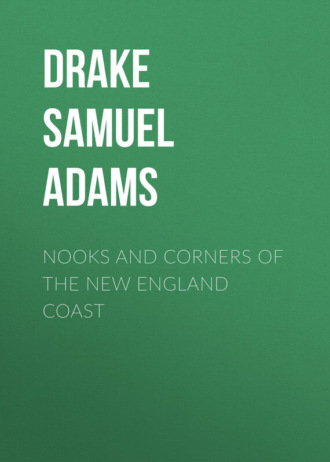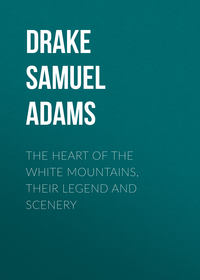 полная версия
полная версияNooks and Corners of the New England Coast
After glancing at the map of the island, I chose Somesville as a central point for my excursions, because it lies at the head of the sound, that divides the island almost in two, is the point toward which all roads converge, and is about equally distant from the harbors or places of particular resort. In summer I should have adopted the same plan until I had fully explored the shores of the Sound, the mountains that are contiguous, and the western half of the island. In twenty-four hours the visitor may know by heart the names of the mountains, lakes, coves, and settlements, with the roads leading to them; he may thereafter establish himself as convenience or fancy shall dictate. At Somesville there is a comfortable hostel, but the larger summer hotels are at Bar Harbor and at South-west Harbor.
The accentuation should not fall on the last, but on the first syllable of Desert, although the name is almost universally mispronounced in Maine, and notably so on the island itself. Usually it is Mount Desart, toned into Desert by the casual population, who thus give it a curious significance.
Mount Desert is one of the wardens of Penobscot Bay, interposing its bulk between the waters of Frenchman's Bay on the east and Blue Hill Bay on the west. A bridge unites it with the main-land in the town of Trenton, where the opposite shores approach within rifle-shot of each other. This point is locally known as the Narrows. When I crossed, the tide was pressing against the wooden piers, in a way to quicken the pace, masses of newly-formed ice that had floated out of Frenchman's Bay with the morning's ebb.
You get a glimpse of Mount Desert in sailing up Penobscot Bay, where its mountains appear foreshortened into two cloudy shapes that you would fail to know again. But the highest hills between Bucksport and Ellsworth display the whole range; and from the latter place until the island is reached their snow-laced sides loomed grandly in the gray mists of a December day. In this condition of the atmosphere their outlines seemed more sharply cut than when thrown against a background of clear blue sky. I counted eight peaks, and then, on coming nearer, others, that at first had blended with those higher and more distant ones, detached themselves. Green Mountain will be remembered as the highest of the chain, Beech and Dog mountains from their peculiarity of outline. A wider break between two hills indicates where the sea has driven the wedge called Somes's Sound into the side of the isle. Western Mountain terminates the range on the right; Newport Mountain, with Bar Harbor at its foot, is at the other extremity of the group. In approaching from sea this order would appear reversed.
The Somesville road is a nearly direct line drawn from the head of the Sound to the Narrows. Soon after passing the bridge, that to Bar Harbor diverged to the left. Crossing a strip of level land, we began the ascent of Town Hill through a dark growth of cedar, fir, and other evergreen trees. A little hamlet, where there is a post-office, crowns the summit of Town Hill. Not long after, the Sound opened into view one of those rare vistas that leave a picture for after remembrance. At first it seemed a lake shut in by the feet of two interlocking mountains, but the vessels that lay fast-moored in the ice were plainly sea-going craft. Somesville lay beneath us, its little steeple pricking the frosty air. Cold, gray, and cheerless as their outward dress appeared, the mountains had more of impressiveness, now that they were covered from base to summit with snow. They seemed really mountains and not hills, receiving an Alpine tone with their wintry vesture.
After all, a winter landscape in New England is less gloomy than in the same zone of the Mississippi Valley, where, in the total absence of evergreen-trees, nothing but long reaches of naked forest rewards the eye, which roves in vain for some vantage-ground of relief. Jutting points, well wooded with dark firs, or clumps of those trees standing by the roadside, were agreeable features in this connection.
A brisk trot over the frozen road brought us to the end of the half-dozen miles that stretch between Somesville and the Narrows. The snow craunched beneath the horses' feet as we glided through the village street; in a moment more the driver drew up with a flourish beside the door of an inn which bears for its ensign a name advantageously known in these latitudes. A rousing fire of birchen logs blazed on the open hearth. Above the mantel were cheap prints of the presidents, from Washington to Buchanan. I was made welcome, and thought of Shenstone when he says,
"Whoe'er has travel'd life's dull round,Whate'er his fortunes may have been,Must sigh to think how oft he's foundLife's warmest welcome at an inn."An island fourteen miles long and a dozen broad, embracing a hundred square miles, and traversed from end to end by mountains, is to be approached with respect. It excludes the idea of superficial observation. As the mountains bar the way to the southern shores, you must often make a long détour to reach a given point, or else commit yourself to the guidance of a deer-path, or the dry bed of some mountain torrent. In summer or in autumn, with a little knowledge of woodcraft, a well-adjusted pocket-compass, and a stout staff, it is practicable to enter the hills, and make your way as the red huntsmen were of old accustomed to do; but in winter a guide would be indispensable, and you should have well-trained muscles to undertake it.
The mountains have been traversed again and again by fire, destroying not the wood alone, but also the thin turf, the accumulations of years. The woods are full of the evidences of these fires in the charred remains of large trees that, after the passage of the flames, have been felled by tempests. At a distance of five miles the present growth resembles stubble; on a nearer approach it takes the appearance of underbrush; and upon reaching the hills you find a young forest repairing the ravages made by fire, wind, and the woodman's axe. "Fifty years ago," said Mr. Somes, "those mountains were covered with a dark growth." Cedars, firs, hemlocks, and other evergreens, with a thick sprinkling of white-birch, and now and then a clump of beeches, make the principal base for the forest of the future on Mount Desert – provided always it is permitted to arrive at maturity. Hitherto the poverty or greed of the inhabitants has sacrificed every tree that was worth the labor of felling. In the neighborhood of Salisbury's Cove there are still to be seen in inaccessible places, trees destined never to feel the axe's keen edge.
Mine host of the village tavern, Daniel Somes, or "Old Uncle Daniel," as he is known far and near, is the grandson of the first settler of the name who emigrated from Gloucester, Massachusetts, and "squatted" here – "a vile phrase" – about 1760. Abraham Somes built on the little point of land in front of the tavern-door, from which a clump of shrubs may be seen growing near the spot. Other settlers came from Cape Cod, and were located at Hull's and other coves about the island. I asked my landlord if there were any family traditions relative to the short-lived settlement of the French, or traces of an occupation that might well have set his ancestors talking. He shook his gray head in emphatic negative. Had I asked him for "Tam O'Shanter" or the "Brigs of Ayr," he would have given it to me stanza for stanza.
There are few excursions to be made within a certain radius of Somesville that offer so much of variety and interest as that on the western side of the Sound, pursuing, with such wanderings as fancy may suggest, the well-beaten road to South-west Harbor. It is seven miles of hill and dale, lake and stream, with a succession of charming views constantly unfolding themselves before you. And here I may remark that the roads on the island are generally good, and easily followed.
The map may have so far introduced the island to the reader that he will be able to trace the route along the side of Robinson's Mountain, which is between the road and the Sound, with two summits of nearly equal height, rising six hundred and forty and six hundred and eighty feet above it. At the right, in descending this road, is Echo Lake, a superb piece of water, having Beech Mountain at its foot. You stumble on it, as it were, unawares, and enjoy the surprise all the more for it. Broad-shouldered and deep-chested mountains wall in the reservoirs that have been filled by the snows melting from their sides. There are speckled trout to be taken in Echo Lake, as well as in the pond lying in Somesville. Of course the echo is to be tried, even if the mount gives back a saucy answer.
Next below us is Dog Mountain. It has been shut out from view until you have uncovered it in passing by the lake. Dog Mountain's eastern and highest crest is six hundred and eighty feet in the air. How much of resemblance it bears to a crouching mastiff depends in a great measure upon the imagination of the beholder:
Ham. "Do you see yonder cloud that's almost in shape of a camel?"
Pol. "By the mass, and 'tis like a camel indeed."
Ham. "Methinks it is like a weasel."
Pol. "It is backed like a weasel."
Ham. "Or like a whale?"
Pol. "Very like a whale."
Between Dog and Brown's Mountain on its eastern shore the Sound has forced its way for six or seven miles up into the centre of the island. At the southern foot of Dog Mountain is Fernald's Cove and Point, the supposed scene of the attempted settlement by the colony of Madame the Marchioness De Guercheville. Mr. De Costa has christened Brown's Mountain with the name of Mansell, from Sir Robert Mansell, vice-admiral in the times of James I. and Charles I. The whole island was once called after the knight, but there is a touch of retributive justice in recollecting that the English, in expelling the French, have in turn been expelled from its nomenclature.
Turning now to what Prescott calls "historicals" for enlightenment on the subject of the colonization of Mount Desert, it appears that upon the return of De Monts to France he gave his town of Port Royal to Jean de Poutrincourt, whose voyage in 1606 along the coast of New England will be noticed in future chapters. The projects of De Monts having been overthrown by intrigue, and through jealousy of the exclusive rights conferred by his patent, Madame De Guercheville, a "very, charitable and pious lady" of the court,13 entered into negotiation with Poutrincourt for the founding of Jesuit missions among the savages. Finding that Poutrincourt claimed more than he could conveniently establish a right to, Madame treated directly with Du Guast, who ceded to her all the privileges derived by him from Henry IV. The king, in 1607, confirmed all except the grant of Port Royal, which was reserved to Poutrincourt. The memorable year of 1610 ended the career of Henry, in the Rue de la Ferronerie. In 1611 the fathers, Père Biard and Enemond Masse, of the College d'Eu, came over to Port Royal with Biencourt, the younger Poutrincourt. During the next year an expedition under the auspices of Madame De Guercheville was prepared to follow, and, after taking on board the two Jesuits already at Port Royal, was to proceed to make a definitive settlement somewhere in the Penobscot.
The colonists numbered in all about thirty persons, including two other Jesuit fathers, named Jacques Quentin and Gilbert Du Thet.14 The expedition was under the command of La Saussaye. In numbers it was about equal to the colony of Gosnold.
La Saussaye arrived at Port Royal, and after taking on board the fathers, Biard and Masse, continued his route. Arriving off Menan, the vessel was enveloped by an impenetrable fog, which beset them for two days and nights. Their situation was one of imminent danger, from which, if the relation of the Père Biard is to be believed, they were delivered by prayer. On the morning of the third day the fog lifted, disclosing the island of Mount Desert to their joyful eyes. The pilot landed them in a harbor on the east side of the island, where they gave thanks to God and celebrated the mass. They named the place and harbor St. Sauveur.
Singularly enough, it now fell out, as seven years later it happened to the Leyden Pilgrims, that the pilot refused to carry them to their actual destination at Kadesquit,15 in Pentagoët River. He alleged that the voyage was completed. After much wrangling the affair was adjusted by the appearance of friendly Indians, who conducted the fathers to their own place of habitation. Upon viewing the spot, the colonists determined they could not do better than to settle upon it. They accordingly set about making a lodgment.16
The place where the colony was established is obscured as much by the relation of Biard as by time itself. The language of the narration is calculated to mislead, as the place is spoken of as "being shut in by the large island of Mount Desert." The Jesuit had undoubtedly full opportunity of becoming familiar with the locality, and his account was written after the dissolution of the plantation by Argall. There is little doubt they were inhabiting some part of the isle, as Champlain in general terms asserts. Meanwhile the grassy slope of Fernald's Point gains many pilgrims. The brave ecclesiastic, Du Thet, could not have a nobler monument than the stately cliffs graven by lightning and the storm with the handwriting of the Omnipotent. The puny reverberations of Argall's broadsides were as nothing compared with the artillery that has played upon these heights out of cloud battlements.
During the summer of 1613, Samuel Argall, learning of the presence of the French, came upon them unawares, and in true buccaneer style. A very brief and unequal conflict ensued. Du Thet stood manfully by his gun, and fell, mortally wounded. Captain Flory and three others also received wounds. Two were drowned. The French then surrendered.
Argall's ship was called the Treasurer. Henri de Montmorency, Admiral of France, demanded justice of King James for the outrage, but I doubt that he ever received it. He alleged that, besides killing several of the colonists and transporting others as prisoners to Virginia, Argall had put the remainder in a little skiff and abandoned them to the mercy of the waves. Thus ended the fourth attempt to colonize New England.
Argall, it is asserted, had the baseness to purloin the commission of La Saussaye, as it favored his project of plundering the French more at his ease, the two crowns of England and France being then at peace. He was afterward knighted by King James, and became a member of the Council of Plymouth, and Deputy-governor of Virginia. During a second expedition to Acadia, he destroyed all traces of the colony of Madame De Guercheville. It is pretty evident he was a bold, bad man, as the more his character is scanned the less there appears in it to admire.
Brother Du Thet, standing with smoking match beside his gun, was worthy the same pencil that has illustrated the defense of Saragossa. I marvel much the event has not been celebrated in verse.
An enjoyable way of becoming acquainted with Somes's Sound is to take a wherry at Somesville and drift slowly down with the ebb, returning with the next flood. In some respects it is better than to be under sail, as a landing is always easily made, and defiance may be bidden to head winds.
One of the precipices of Dog Mountain, known as Eagle Cliff, has always attracted the attention of the artists, as well as of all lovers of the beautiful and sublime. There has been much search for treasure in the glens hereabouts, directed by spiritualistic conclaves. One too credulous islander, in his fruitless delving after the pirate Kidd's buried hoard, has squandered the gold of his own life, and is worn to a shadow.
When some one asked Moll Pitcher, the celebrated fortune-teller of Lynn, to disclose the place where this same Kidd had secreted his wealth, promising to give her half of what was recovered, the old witch exclaimed, "Fool! if I knew, could I not have all myself?" Kidd's wealth must have been beyond computation. There is scarcely a headland or an island from Montauk to Grand Menan which according to local tradition does not contain some portion of his spoil.
Much interest is attached to the shell heaps found on Fernald's Point and at Sand Point opposite. There are also such banks at Hull's Cove and elsewhere. Indian implements are occasionally met with in these deposits. It is reasonably certain that some of them are of remote antiquity. Williamson states that a heavy growth of trees was found by the first settlers upon some of the shell banks in this vicinity.17 Associated with these relics of aboriginal occupation is the print in the rock near Cromwell's Cove, called the "Indian's Foot." It is in appearance the impression of a tolerably shaped foot, fourteen inches long and two deep. The common people are not yet freed from the superstitions of two centuries ago, which ascribed all such accidental marks to the Evil One.
In my progress by the road to South-west Harbor, I was intercepted near Dog Mountain by a sea-turn that soon became a steady drizzle. This afforded me an opportunity of seeing some fine dissolving views: the sea-mists advancing, and enveloping the mountain-tops, cheated the imagination with the idea that the mountains were themselves receding. A storm-cloud, black and threatening, drifted over Sargent's Mountain, settling bodily down upon it, deploying and extending itself until the entire bulk disappeared behind an impenetrable curtain. It was like the stealthy approach and quick cast of a mantle over the head of an unsuspecting victim.
Very few were abroad in the storm, but I saw a nut-cracker and chickadee making the best of it. I remarked that under branching spruces or fir-trees the grass was still green, and the leaves of the checker-berry bright and glossy as in September. On this road admirable points of observation constantly occur from which to view the shifting contours of Beech and Western mountains, with the broad and level plateau extending along their northern baseline far to the westward. Retracing with the eye this line, you see a little hamlet snugly ensconced on the hither slope of Beech Mountain, while the plateau is rounded off into the bluffs rising above Echo Lake.
South-west Harbor is usually the stranger's first introduction to Mount Desert. The approach to it is consequently invested with peculiar interest to all who know how to value first impressions. Its neighborhood is less wild and picturesque than the eastern shores of the island, but Long Lake and the western range of mountains are conveniently accessible from it; while, by crossing or ascending the Sound, avenues are opened in every direction to the surpassing charms of this favored corner of New England.
At South-west Harbor the visitor is usually desirous of inspecting the sea-wall, or cheval-de-frise of shattered rock, that skirts the shore less than three miles distant from the steamboat landing. And he may here witness an impressive example of what the ocean can do. An irregular ridge of a mile in length is piled with shapeless rocks, against which the sea beats with tireless impetuosity.
Fog is the bane of Mount Desert. Its frequency during the months of July and August is an important factor in the sum of outdoor enjoyment. Happily, it is seldom of long continuance, as genial sunshine or light breezes soon disperse it.
There is, however, a weird sort of fascination in standing on the shore in a fog. You are completely deceived as to the nearness either of objects or of sounds, though the roll of the surf is more depended upon by experienced ears than the fog-bell. In sailing near the land every one has noticed the recoil of sounds from the shore, as voices, or the beat of a steamer's paddles. Coming through the Mussel Ridge Channel one unusually thick morning, the fog suddenly "scaled up," discovering White Head in uncomfortable proximity. The light-house keeper stood in his door, tolling the heavy fog-bell that we had believed half a mile away. Our pilot gave him thanks with three blasts of the steam-whistle.
Off the entrance to the Sound are several islands – Great Cranberry, of five hundred acres; Little Cranberry, of two hundred acres; and, farther inshore, Lancaster's Island, of one hundred acres. The eastern channel into the Sound is between the two last named. Duck Island, of about fifty acres, is east of Great Cranberry; and Baker's, on which is the light-house, is the outermost of the cluster.
The cranberry is indigenous to the whole extent of the Maine sea-board. It grows to perfection on the borders of wet meadows, but I have known it to thrive on the upland. The culture has been found very remunerative in localities less favored by nature, as at Cape Cod and on the New Jersey coast. Some attempts at cranberry culture have recently been made with good success at Lemoine, on the main-land, opposite Mount Desert. Blue-berries are abundant on Mount Desert. I saw one young girl who had picked enough in a week to bring her seven dollars. Formerly they were sent off the island, but they are now in good demand at the hotels and boarding-houses. In poorer families the head of it picks up a little money by shore-fishing. He plants a little patch with potatoes, dressing the land with sea-weed, which costs him only the labor of gathering it. His fire-wood is as cheaply procured from the neighboring forest or shore, and in the autumn his wife and children gather berries, which are exchanged for necessaries at the stores.
At the extreme southerly end of Mount Desert is Bass Harbor, with three islands outlying. It is landlocked, and a well-known haven of refuge.
CHAPTER III.
CHRISTMAS ON MOUNT DESERT
"You should have seen that long hill-range,With gaps of brightness riven —How through each pass and hollow streamedThe purpling light of heaven – "Whittier.Having broken the ice a little with the reader, I shall suppose him present on the most glorious Christmas morning a New England sun ever shone upon. "A green Christmas makes a fat church-yard," says an Old-country proverb; this was a white Noël, cloudless and bright. I saw that the peruke of my neighbor across the Sound, Sargent's Mountain, had been freshly powdered during the night; that the rigging of the ice-bound craft harbored between us was incased in solid ice, reflecting the sunbeams like burnished steel. The inscription on mine host's sign-board was blotted out by the driving sleet; the brown and leafless trees stood transfigured into objects of wondrous beauty. I heard the jingle of bells in the stable-yard and the stamping of feet below stairs, and then
"I heard nae mair, for ChanticleerShook off the pouthery snaw,And hail'd the morning with a cheer,A cottage-rousing craw."The roads from Bar Harbor and from North-east Harbor unite within a short distance of Somesville, and enter the village together. Within these highways is embraced a large proportion of those picturesque features for which the island is famed. In this area are the highest mountains, the boldest headlands, the deepest indentations of the shores. It is not for nothing, therefore, that Bar Harbor has become a favorite rendezvous of the throngs
"That seek the crowd they seem to fly."
On Christmas-day the road to Bar Harbor was an avenue of a winter palace more sumptuous than that by the Neva. Every spray of the dark evergreen trees was heavily laden with a light snow that plentifully besprinkled us in passing beneath the often overreaching branches. The stillness was unbroken. Blasted trees – gaunt, withered, and hung with moss like rags on the shrunken limbs of a mendicant – were now incrusted with ice-crystals, that glittered like lustres on gigantic candelabra. On the top of some rounded hill there sometimes was standing the bare stem of a blasted pine, where it shone like the spike on a grenadier's helmet. It was a scene of enchantment.
I saw frequent tracks where the deer had come down the mountain and crossed the road, sometimes singly, sometimes in pairs, and in search, no doubt, of water. The foot-prints of foxes, rabbits, and grouse were also common. During the day I met an islander who told me he had shot a fat buck only a day or two before, and that many deer were still haunting the mountains. Formerly, but so long ago that only tradition preserves the fact, there were black bear and moose; and traces of beaver are yet to be seen in their dams and houses. Red foxes and mink, and occasionally the black fox, greatly valued for its fur, are taken by the hunters. In order to make the roads interesting to nocturnal travelers, rumor was talking of a panther and a wolf that had been seen within a short time.









